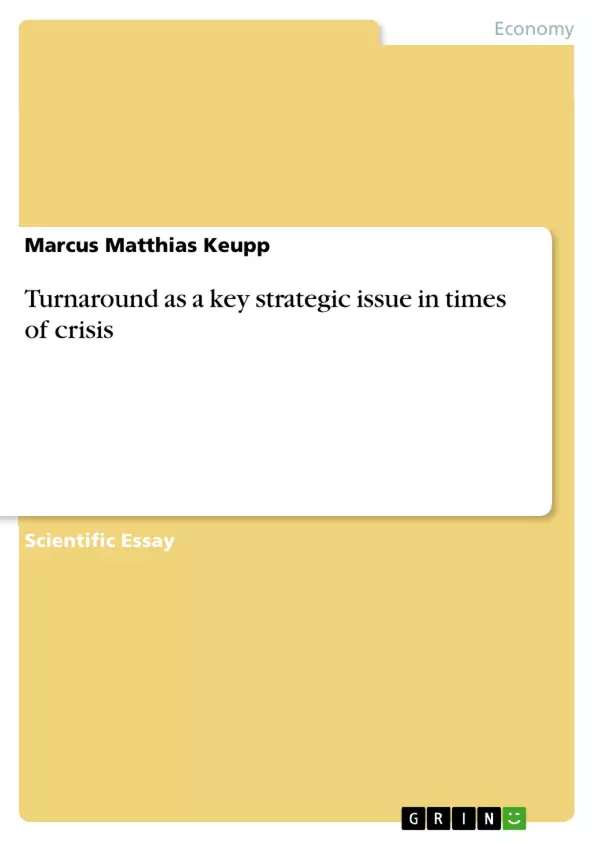After years of ever-increasing profits, the ailing British retailer Marks and Spencer (M&S) has fallen out of favour with British customers. Sales and profit strongly declined, followed by shakeups in the top management team. M&S faced extinction when confronted with Philip Green′s takeover plans. Top management have made efforts to turn M&S around. The analytical approach to assess these efforts is as follows:
Having evaluated turnaround models (Chapter 1), I will observe actions undertaken by M&S (Chapter 2), finally putting both sides together, determining if the actions fit the model (Chapter 3). Introducing competitive advantage as the measurement for success (Chapter 4), the conclusion (Chapter 5) will show that M&S is just one example for a problem that goes far deeper.
Inhaltsverzeichnis (Table of Contents)
- Introduction: The Analytical Approach
- Chapter 1: The Theory on Corporate Turnarounds
- Chapter 2: M&S's Actions
- 2.1 Definition of an appropriate timeframe
- 2.2 Process of evaluation of key actions
- Chapter 3: Matching Theory and Practice
- 3.1 So which case example fits the M&S case?
- Chapter 4: Competitive Advantage as a Measurement for Success
Zielsetzung und Themenschwerpunkte (Objectives and Key Themes)
This individual assessment explores the challenges faced by Marks and Spencer (M&S) during a period of significant decline and examines the turnaround efforts undertaken by the company. The author aims to analyze the effectiveness of these efforts by applying a specific turnaround model to the M&S case. The study considers the context of corporate decline, various turnaround models, and the specific actions taken by M&S in response to its challenges.
- Corporate Turnaround Models: Analyzing different theories and their applicability to real-world situations.
- Strategic Response to Crisis: Evaluating the effectiveness of M&S's actions in addressing its decline.
- Competitive Advantage: Assessing the potential for M&S to regain a competitive edge.
- Corporate Decline and Recovery: Understanding the factors that contribute to corporate decline and the strategies employed to overcome it.
Zusammenfassung der Kapitel (Chapter Summaries)
- Chapter 1: The Theory on Corporate Turnarounds: This chapter introduces several turnaround models that could be applied to the M&S case. The author critically analyzes these models, highlighting their strengths and weaknesses, focusing on their empirical foundations and their applicability to the retail sector. The author concludes by choosing a specific model, the "sharpbender" model, for application to the M&S case.
- Chapter 2: M&S's Actions: This chapter outlines the actions undertaken by M&S during a specific timeframe, focusing on the key actions that aimed to reverse the company's decline. Through an objective evaluation process, the author identifies key actions taken by M&S, including leadership changes, advertising campaigns, supply chain restructuring, store closures, and customer-focused strategies.
- Chapter 3: Matching Theory and Practice: This chapter examines the extent to which M&S's actions align with the chosen turnaround model (the "sharpbender" model). The author analyzes the different case examples within the model and determines the specific case that best reflects the M&S situation.
Schlüsselwörter (Keywords)
This individual assessment focuses on corporate strategy, turnaround management, corporate decline, competitive advantage, retail industry, Marks and Spencer, strategic response, and case studies. The author utilizes various turnaround models, including Slatter's, Bibeault's, and the "sharpbender" model, to analyze M&S's actions during a period of decline. The key themes encompass the effectiveness of different turnaround strategies, the challenges faced by struggling companies, and the importance of adapting to changing market conditions.
- Quote paper
- Marcus Matthias Keupp (Author), 2001, Turnaround as a key strategic issue in times of crisis, Munich, GRIN Verlag, https://www.grin.com/document/7762



